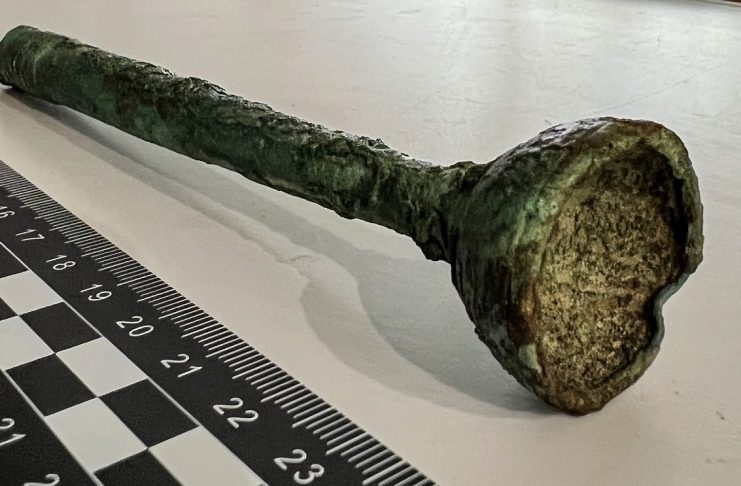
Buried deeply below the remains of a schola (officers’ club house) and left with the debris over a Hadrianic workshop floor, a remarkable musical discovery was made in the silty mud on the Vindolanda excavations this year.
Appropriated by the Romans from its Etruscan origins, the Cornu was used throughout the Empire in a military capacity, with two cornicenes (horn-blowers) blowing their horns as the army marched.
An extremely rare copper alloy cornu mouthpiece, dated to AD120-128, was uncovered in May of this year. The object, which is a first of its kind in the Vindolanda collection, has now completed the conservation process and is undergoing further research.
The cornu (Latin “horn”, both musical and animal) was an instrument around 3m long, curled into a letter ‘G’ shape and was commonly supported by a wooden pole, allowing for some of the weight to be held on the shoulder. Cornua are depicted in many Roman settings on imagery with military, ceremonial and entertainment use.
The Roman army used the cornu to transmit orders to the troops in battle and the cornu is depicted on Roman military art such as Trajan’s Column in Rome as accompanying the movement of the standards.
The Cornu was also used in Roman society, sometimes paired in combination with the Lituus and occasionally played at Chariot races, where the cornicen would blow their horn to encourage the charioteers and their horses in a final lap of the amphitheatre. It is the excitement of the race, the crowd rushing forward on the final lap and the euphoria for the winner as he races to the finish that is to be symbolized sonically.
“This is a really exciting find here at Vindolanda”, stated the Trust’s Curator Barbara Birley. “We know that instruments like the cornu existed in the ancient world but when you find part of a musical instrument it helps us to build a better picture of not just what the army looked like but also how they sounded. This discovery along with exceptional artefacts like the Vindolanda writing tablets, thin handwritten wooden letters, add so much more to our historical understanding of this remarkable Roman fort”.
Dr Andrew Birley, Director of Excavations at the Trust commented
“Finds like this bring another dimension to our appreciation of life and the ruins left behind, a soundscape to go with the smellscape of the Hadrianic forts and remains and it is apt that we made this discovery in the year that we celebrate 1900 years since the building of Hadrian’s Wall commenced”.
Abraham Cupeiro plays the Cornu de Pompeii
The MDX team is an active group of researchers based in the Faculty of Science and Technology of the Design Engineering and Mathematics Department.
They credit the use of 3-D printing as a fantastic tool that allows them to create prototypes overnight instead of having to spend weeks crafting individual wooden or brass test instruments.
Analysis of excavated cornua as well as the other instruments have allowed reproductions to be made so we can hear how they may have sounded. A live performance at Vindolanda, with musician Letty Scott performing on a replica cornu will take place on Sunday 25th September 2022.

The Cornu that I will perform on at Vindolanda is a 3-D analog of a Pompeiian Cornu, designed and built by Dr Peter Holmes and his colleague at Middlesex University, Neil Melton. It is modelled on several Cornu discovered in Pompeii, which are some of the largest versions of the instrument, and which therefore yield the greatest number of pitches to the player. [Letty Stott]
Letty Stott is one of the UK’s most exciting and versatile horn players, with her career spanning across a wide variety of genres.
Event details
Vindolanda, NE47 7JN
Start: 25th September, 2022 at 11:00am
End: 25th September, 2022 at 3:00pm
The newly uncovered mouthpiece will join the other exciting artefacts from the 2022 excavations in the ‘new finds case’ in the Vindolanda Museum from Easter of next year.
Source: Archaeology Wiki
https://www.archaeology.wiki